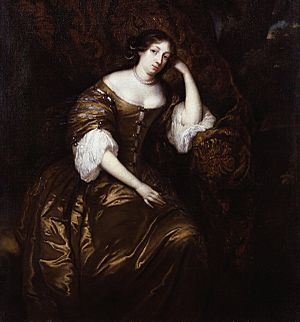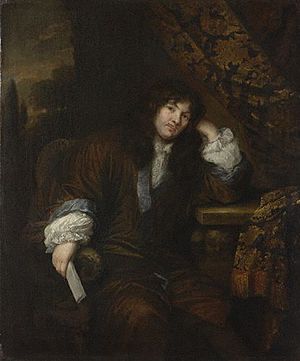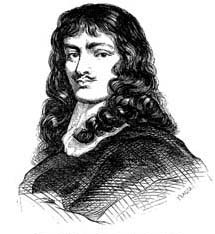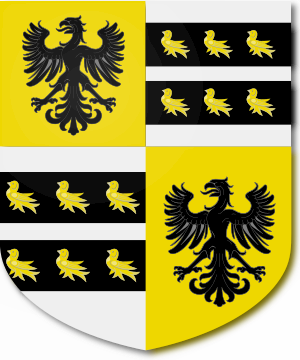Sir William Temple, 1st Baronet facts for kids
Sir William Temple, 1st Baronet (April 25, 1628 – January 27, 1699) was an English diplomat, statesman, and writer. He was a very important diplomat who later became a key advisor to King Charles II. After a disagreement with the King, he retired from public life. He then spent his time enjoying gardening and writing.
Today, he is mostly remembered for two things:
- A passage he wrote about Chinese gardens, even though he had never seen one. This writing helped inspire the English landscape garden style, which liked natural, irregular designs.
- For hiring the famous writer Jonathan Swift as his secretary.
Life Story
William Temple was born in London. His father, Sir John Temple, was an Irish judge. William studied at Emmanuel College, Cambridge, and then traveled across Europe. He also served in the Irish Parliament and went on many diplomatic missions.
As a diplomat, Temple was very successful. He helped create the Triple Alliance of 1668, which was an important agreement between England, the Netherlands, and Sweden. He also helped arrange the marriage between Prince William of Orange and Princess Mary of England in 1677.
When he returned to England in 1679, King Charles II often asked for his advice. However, Temple did not agree with the King's plans against the Dutch. Because of this, he decided to retire to his home in Sheen.
Later, he was asked to return to help reform the government. He designed a plan for the Privy Council Ministry in 1679. This plan was an early idea for what we now call a Cabinet government, where a group of advisors helps the leader. King Charles II did not like the plan because he felt it took away too much of his power. However, he allowed it to be tried for a short time.
Temple later moved from Sheen and bought a house near Farnham around 1686. He renamed it Moor Park. He loved this house and its gardens, which were inspired by another house called Moor Park, Hertfordshire.
It was at this Moor Park that the famous writer Jonathan Swift worked as his secretary for many years, starting in 1689. Swift also met Esther Johnson here, who became his lifelong friend. Temple loved his retirement at Moor Park and even put his family motto, "God has given us these opportunities for tranquility," above the door.
Temple did not take part in the Glorious Revolution of 1688, which changed who was king. He accepted the new rulers and was offered a job as Secretary of State, but he turned it down.
Sir William Temple passed away at Moor Park, Surrey, England in 1699. He was buried in Westminster Abbey. His friends missed him greatly. Jonathan Swift wrote that "all that was good and amiable in mankind departed with him."
Family Life

In 1654, Temple married Dorothy Osborne (who passed away in 1695). Their marriage was based on love, and they were known for being very loyal to each other. Dorothy refused to marry other people her family suggested, choosing William instead.
After Dorothy died, William's strong-willed sister, Martha, Lady Giffard, helped him manage his home. She had been widowed young and had spent many years with William and Dorothy. Martha wrote a short book about her brother's life, which was published after her death in 1722.
Sir William and Dorothy Osborne had children, including:
- John Temple (died 1689). He was given important roles in government, like Paymaster General and Secretary at War. Sadly, he died young in a tragic accident.
* John had two daughters: * Elizabeth Temple, who married her cousin, John Temple. They had no children. * Dorothy Temple, who married Nicholas Bacon. They had children.
Letters written by Dorothy to William before they were married have been published and are still read today.
Retirement and Gardens
Temple saw his retirement to his country home at Moor Park as following the example of the Greek philosopher Epicurus. Epicurus believed in living a simple, peaceful life. In his essay "Upon the Gardens of Epicurus," written in 1685, Temple wrote about how much he enjoyed his quiet life. He said he had spent five years there without going to the city, after deciding not to work in public life again.
In this essay, Temple used the term sharawadgi, which describes a beautiful, natural, and irregular style of garden design. Because of this, some people see him as one of the first to think about the English landscape garden style, which favored natural beauty over strict, formal designs.
Many later writers praised Temple's writing style. They described it as clear, pleasant, and interesting, like having a conversation with a friend. Some even said he was the first writer to give a good rhythm to English prose.
Death
Sir William Temple died on January 27, 1699. He was buried in Westminster Abbey. However, he had a special wish: his heart was placed in a silver box under the sundial at Moor Park, near his favorite window seat. Jonathan Swift wrote about his death, saying, "He died at one o clock in the morning and with him all that was great and good among men."
See also
 In Spanish: William Temple para niños
In Spanish: William Temple para niños
- General opinion, a concept Temple wrote about in his Essay on the Original and Nature of Government
- Archive.org: "Temple, William, Sir, 1628-1699"




